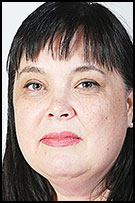Let's all plan together for McMinnville's future
Growth.
It’s complex. It’s emotional. It’s personal. It means so many different things to so many different people.
Growth is good; growth is bad. We don’t want any more growth; we need to continue to grow as a community.
We are building too much housing; we don’t have enough housing. I love McMinnville just the way it is; McMinnville is becoming too congested and expensive.
We don’t like sprawl that eats into surrounding farmland, but we don’t like density either. We do not want to look like Portland metro or become swallowed up in it.
But where are my children — and their children — going to live and work? And how am I going to recruit new employees if they can’t find a place to live?
In the planning department, we hear it all. And truth be told, McMinnville is going to grow whether or not we like it.
In fact, we are required by state law to grow. We are required to plan for at least 20 years of growth and prove we have enough land inventory to provide the housing, parks, schools, public facilities and employment that come with it.
McMinnville was platted in 1856 by William Newby. On its 50th anniversary in 1906, it had 2,200 residents.
Now, more than 100 years later, McMinnville has grown to 34,500 residents, making it the 17th largest city in Oregon, and serves as the seat of Yamhill County government and commerce.
The state tells us we should anticipate 46,276 residents by 2041, and 62,804 by 2067. That would mean adding about 11,800 in the next 20 years and 28,000 over the next 50 years.
What does that expansion even look like? Imagine adding a community the size of Cornelius or Gladstone in the next 20 years and Tualatin or Redmond in the next 50.
But nothing is impossible. As a community, we can set the stage for the next generation of residents with sound planning. We can put plans in place to ensure our children and grandchildren get to enjoy a wonderful community, just like we do.
This does not happen with individuals making individual decisions on their own. This happens when communities come together.
We need to dream together, envision the future together, create the opportunities together. We need to discuss our fears and identify measures to prevent them from being realized.
We need to do it now, as we are at a turning point.
Our limited housing supply and continually rising land prices are causing us to struggle. No matter how much we want to change the current market, we will not be successful until we have a greater supply of land in order to respond to demand.
Until recently, we had been issuing 40% to 50% of our historical annual average of new dwelling permits for about 10 years. We had historically averaged approximately 200 new homes per year, but had been averaging 100 or fewer in recent years, gradually creating a cumulative deficit of 600 to 1,000 homes.
Why is that?
The are many factors, including the Great Recession. However, one stands out: The readily available land supply for development in McMinnville is scarce.
Developers are simply running out of land to build on. Two of the most prominent local developers are currently building on their last parcels, and have had little luck acquiring replacement inventory.
For some, that might be a good thing. “Good, they say. We don’t want the growth anyway.”
But in reality, that it is contributing to the housing supply issue, which is contributing to the housing affordability issue. And it is now becoming an issue for our business community, because new employees can’t find a place to live in McMinnville.
Additionally, without growth, the tax base begins falling short of paying the annual cost of public services, which is rising at a rate of 5% to 7% a year, but state law limits local government tax base increases to 3%, based on the expectation that growth will fill the gap.
If that growth doesn’t occur, the current tax base cannot continue to support the existing level of public services. Communities then face either reducing serve levels or levying new taxes.
As a result, Oregon cities that aren’t growing are either deteriorating or gentrifying. While the level of service is declining, the cost of housing is rising, making life favorable only for the wealthy.
If the state requires us to provide planning and inventory to support 20 years of growth, why are we at this juncture today?
In 1981, McMinnville created an urban growth boundary to support McMinnville’s expansion from 1980 to 2000. In 1993, it initiated the work on a new growth plan to carry it through from 2000 to 2020.
However, despite 20 years of trying, the city has never been able to advance that plan. After years of appeals burning through $1 million of city tax dollars and thousands of hours of city staff time, McMinnville elected to put its UGB expansion effort on hold in 2013.
This tells us one thing: McMinnville is at the heart of conflict in Oregon’s land use system between a city’s needs to accommodate growth and to preserve productive forest and farmland.
In the planning field, Oregon’s land use system is widely considered the best in the United States. However, our primary focus has been on preservation of farm and forest land, not on city planning.
We spend more time analyzing impact of city growth on farm and forest land than evaluating how to plan future cities that provide the best quality of life for future citizens. We have lost sight of the “people” in our planning process.
McMinnville prides itself on the small-town charm of a community of 15,000, even though it is actually one of the larger cities in Oregon. I believe we can maintain this small-town charm, ideal in terms of environment, spirit and community cohesiveness, while growing into a modern city of 45,000.
But we have to put the plans in place to ensure that. We need to be strategic, thoughtful and intentional.
We need to make sure it’s all about people. We need to be ever conscientious of the fact we are investing in the quality of life for future residents.
In the past year, citizen stakeholders have worked diligently on a 20-year plan to meet housing needs, dubbed the Housing Needs Analysis. They evaluated future growth while also attempting to anticipate housing choices for future demographics.
Based on that analysis, we believe we will need to add 5,000 housing units over the next 20 — enough to accommodate 12,000 new residents. We expect 20% of that figure to be subsidized housing, in the form of tiny homes, mobile homes and apartment units; 40% to be unsubsidized housing capable of serving our workforce and lower middle-class, in the form of duplexes, townhomes and cottages; and 40% unsubsidized housing for middle- and upper-income households, in the form of single-family homes, townhomes, higher-end apartments and condominiums.
Where do all these new units go? Do we grow up or out? This led to a discussion of finding middle ground in terms of density and sprawl.
The stakeholder group is recommending the city adopt a plan encouraging higher densities than the historic and current norm, via smaller lots, cottage clusters, duplexes, triplexes and apartments. That means reducing reliance on single-family homes on large lots.
But it is recommending we do so on a more human scale than Portland Metro communities — in a gentler way, with less stack and pack in mid- and high-rise apartment complexes and more neighborhood building. At the same time, it is urging we try once again to expand the urban growth boundary to create more land supply for future housing development in McMinnville, in the form of a thoughtful, well-intentioned and master-planned expansion.
Right now, we feel we need about 400 acres to accommodate residential growth during a target period of 2021 to 2041. We will, of course, also need acreage for additional parks, schools, churches, employers and public utilities and facilities to serve our future population.
Yamhill County encompasses 458,240 acres. The city’s urban growth boundary contains 7,552 acres, or less than 2% of that, even though it houses 1/3 of the county’s total population.
McMinnville is practically surrounded by land zoned for exclusive farm use. The fear has been that any expansion of its urban growth boundary would, thus, negatively affect the supply of Yamhill County farmland.
However, in all, the county has 192,088 acres under exclusive farm use zoning. So if the city expanded its boundary by 800 acres anticipating growth for the next 20 years, and all that acreage was zoned for farm use, it would still be absorbing only 0.4% — less than one-half of 1 percent — to prepare for more than 12,000 people.
The city would be able to accomplish this by committing to a higher level of residential density in the future. That is vastly more efficient than forcing growth into unincorporated areas where lots typically include five to 10 acres, and promises to consume far less farm and forest land.
Growth is a loaded word for some here in McMinnville. But others consider it vital for retaining vitality and creating opportunity.
I am hoping we can have a discussion about growth and the future as a community. I am hoping we can do this with a balanced and realistic perspective. I am hoping that will make us better stewards of our resources for today and tomorrow.
We currently have volunteer citizen committees working on a 20-year strategy for housing, employment, parks and public facilities, residential design standards, a housing strategy for the city core and a master plan for Three Mile Lane and the Highway 18 Bypass. During the coming year, we will be sharing the result and asking you what you think.
Do you like it? Do you hate it? Do you see ways we might make it better?
We will be asking these questions through surveys, open houses, focus groups and so forth. This represents an opportunity for you to get involved in the dialog.
You can find project information on the planning department page at www.mcminnvilleoregon.gov. You can also monitor progress at www.mcminnvillematters.com or the McMinnville Matters Facebook page.
If you want a member of our team to speak to your neighborhood group, service club, fraternal organization or the like, we would be happy to accommodate that.










Comments
Jim
Absolutely the first thing that needs to be addressed is the infrastructure of roads needed to take the traffic from all the additional homes and humans to a usable level. Right now Lafayette Avenue,Baker St. And Adams St are starting to look like Beaverton or Hillsboro at peak traffic times. Till you as a city planner figures out how to move traffic there is no reason to build more houses or add more land to the urban growth boundary. This town wouldn’t need additional public services if we would have grown at a more controlled rate. I for one am scratching my head at the future ghetto getting built on Hill Road. Cracker box houses setting 15’ apart is not my idea of idyllic small town. There is lots of reasons people that have lived here for decades want the growth in McMinnville to be at a slow controlled rate.
GRM
Jim....One couldn't express it better.
Lulu
McMinnville has already lost much of its original character.
Joel
I'm with Jim...it's all about the heavy, congested traffic. Mcminnville has now reached the point where I have to sit at the same intersection through two and sometimes three cycles of the light going from red to greem and back to red again. It's reached the point where you crawl around in bumper to bumper traffic at certain times of the day in area's where that was never the case a few years ago. That's not the small town McMinnville that we moved to back in the early 90's, that's Beaverton or Hillsboro.
Hopefully Ms Richards can pull everyone together and do the best they can to plan McMInnville's future. As for me and my house? We are already looking for a small town of about 10-15k to move to.
gregtompkins
I enjoyed reading this article. But I agree what others have said that McMinnville is now like Beaverton. I grew up in this county lived most of my adult life in Beaverton and came back to this area a few years ago. It has become like Beaverton both McMinnville and Newberg have. And even if they do this thing with dense and vertical housing the traffic is just going to get a lot worse. And where is all the water going to come from? All the “little” towns in the valley all better come together and start building salt water desalination plants at the coast. Cost is going to skyrocket and we need to live in a smaller footprint and learn how to eat less food and drink less water.